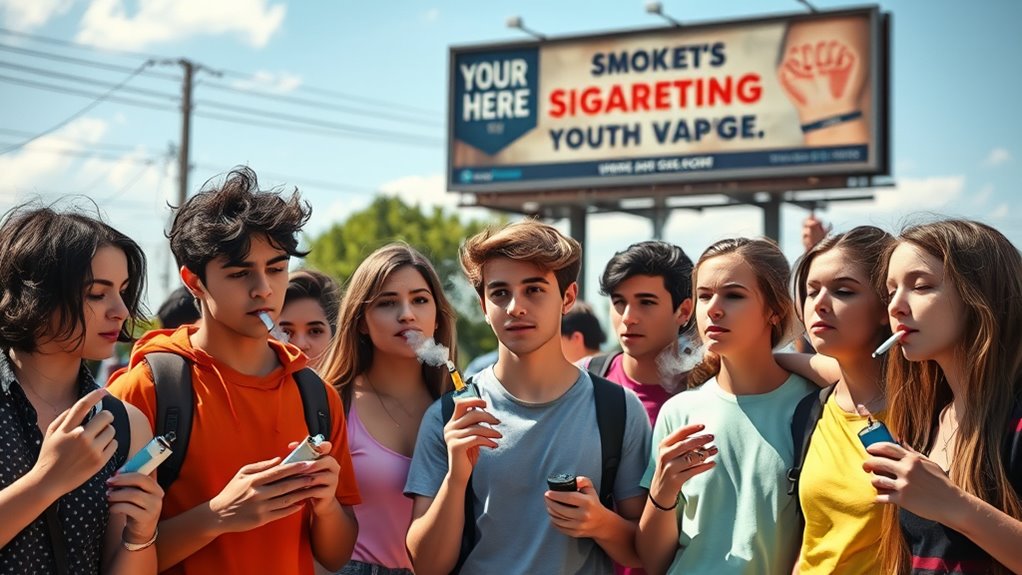The World Health Organization reports that while global smoking rates are declining, youth vaping is surging worldwide. Many young people experiment with e-cigarettes, often believing they’re safer, while marketers target flavors and advertising to minors. This rise poses new public health challenges, risking undoing progress in reducing adult smoking. If you want to understand how policies and education can help protect youth and preserve health gains, there’s more to explore ahead.
Key Takeaways
- WHO reports a global decline in adult smoking rates despite a surge in youth vaping worldwide.
- Youth vaping increases are driven by flavored products and targeted marketing, raising public health concerns.
- Many young people experiment with e-cigarettes without understanding associated health risks.
- Weak regulations and poor enforcement facilitate youth access to vaping products globally.
- Public health strategies focus on education and stricter policies to balance harm reduction and prevent youth uptake.

Despite a steady decline in global smoking rates, the World Health Organization (WHO) reports a sharp rise in youth vaping. This shift raises serious concerns about public health, especially since many young people are experimenting with e-cigarettes without fully understanding the risks involved. As a result, policymakers and health advocates are increasingly focused on how regulatory policies can address this emerging challenge. Your role in understanding these dynamics is vital because effective regulations can help prevent a new generation from falling into nicotine addiction, which has long-term health implications.
Vaping has gained popularity among youth partly because of its marketing tactics, appealing flavors, and perceptions of being a safer alternative to smoking traditional cigarettes. However, the reality is far more complicated. The WHO warns that e-cigarettes contain harmful substances, and their long-term health effects are still uncertain. As a concerned individual, you need to be aware that lax or poorly enforced regulatory policies can make it easier for young people to access these products. Countries with weak regulations often see higher rates of youth vaping, which could undermine decades of public health progress made in reducing smoking rates among adults. Additionally, regulatory frameworks are essential to establishing clear guidelines and standards that can effectively curb youth access.
Regulatory policies are your first line of defense in curbing youth vaping. Many nations are considering or implementing measures such as banning flavored e-cigarettes, restricting marketing targeted at young audiences, and setting age limits for purchase. These policies aim to reduce the appeal of vaping to minors and limit their exposure to addictive substances. You can support these efforts by advocating for stricter regulations and staying informed about policy changes in your area. When governments tighten controls, they send a clear message that protecting youth from nicotine addiction is a priority.
Supporting stricter regulations helps protect youth from nicotine addiction and promotes public health.
However, the effectiveness of regulatory policies depends on enforcement. Without proper oversight, illegal sales and online purchases continue, making it easy for youth to bypass restrictions. That’s why public health agencies are calling for all-encompassing strategies that combine regulation with education campaigns. These campaigns can inform young people about the potential health risks of vaping and dispel misconceptions about its safety. As a member of your community, you can contribute by sharing accurate information and encouraging responsible attitudes toward these products. Furthermore, recent research on AI Security suggests that leveraging advanced technology could assist in monitoring and enforcing these regulations more effectively. These innovations could help identify illegal sales and online marketing targeting youth, ensuring policies are more than just words on paper.
Ultimately, balancing harm reduction with caution is key. While some argue that e-cigarettes can help adult smokers quit, their unchecked availability to youth poses a new public health threat. Your understanding of how regulatory policies shape the landscape can make a difference. Supporting strong, well-enforced regulations helps protect the health of future generations and ensures that progress in reducing traditional smoking isn’t undone by a new wave of nicotine addiction among youth.
Frequently Asked Questions
How Does Vaping Affect Long-Term Lung Health?
Vaping can negatively affect your long-term lung health by causing airway inflammation, which may lead to breathing difficulties. You might also develop lung fibrosis, where lung tissue becomes scarred and stiff, reducing lung function over time. While vaping is often seen as less harmful than smoking, it still exposes your lungs to chemicals that can damage your airways and increase the risk of chronic lung issues in the future.
What Policies Effectively Reduce Youth Vaping Rates?
Imagine a world where youth vaping drops dramatically overnight. You can make that happen by supporting policies like flavor bans and strict age restrictions. These measures deter young people from experimenting with e-cigarettes, reducing initiation and addiction risks. When you advocate for such policies, you’re actively protecting youth from the allure of flavored vapes and ensuring tighter control over who can access these products, creating a healthier future for everyone.
Are E-Cigarettes Safer Than Traditional Cigarettes?
You might think e-cigarettes are safer than traditional cigarettes, but they still contain nicotine, which can lead to addiction. While some see vaping as a harm reduction, the risks aren’t fully clear. Flavor bans aim to reduce appeal to youth, but they don’t eliminate the risk of nicotine addiction. So, it’s safest to avoid both, especially since vaping can still harm your lungs and health.
How Is the WHO Monitoring Vaping Trends Globally?
You can see that the WHO monitors vaping trends globally by analyzing data from various countries, tracking usage patterns among youth, and evaluating marketing strategies used by e-cigarette companies. They face regulatory challenges in keeping up with new products and misleading marketing tactics. The WHO’s efforts include collecting reports, collaborating with governments, and promoting policies to curb youth vaping while addressing the rapidly evolving market landscape.
What Support Exists for Youth Quitting Nicotine?
Like Odysseus steering treacherous waters, you find support through teen cessation programs and peer support networks that combat nicotine addiction. These initiatives offer counseling, educational resources, and community encouragement to help youth quit vaping. Schools and health organizations actively promote these efforts, empowering you with tools and camaraderie—making the journey away from nicotine less lonely and more achievable. You’re not alone in this battle; support surrounds you.
Conclusion
So, while the world cheers as smoking rates drop, you might wonder if the real victory is just shifting smoke from cigarettes to vapes. As youth embrace vaping in ever-increasing numbers, it’s almost poetic—public health’s grand win, or just a new way to hide the smoke behind a cloud of flavor. Meanwhile, you can sit back and enjoy the show, marveling at how society’s battle against cigarettes becomes a stylish, fruity affair.









